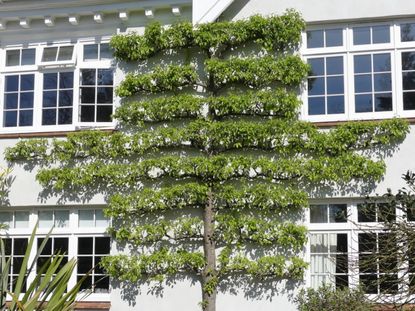How To Espalier: Instructions For Fruit Tree Training


Espalier trees are the result of intense training, in which the plants are urged to grow flat against a wall, fence, or trellis. While nearly any plant can be espaliered, including vines and climbing plants like ivy and roses, most people prefer using fruit trees such as apple and plum. An espalier fruit tree can make an exceptional focal point for bare areas along the outdoor walls of the home or other structures. When trained on a trellis, these plants can also serve as attractive screens to hide unsightly views or to add privacy. Read on to learn more about how to espalier and fruit tree training.
Fruit Tree Training
You can train espalier trees by removing undesired growth. The best plants for espalier fruit tree training are those with flexible branches. There are several ways how to espalier plants, from simple informal designs to more complex training patterns like cordon, basket weave, and candelabra. The method you choose generally determines what plant you use, and the maintenance required. For instance, informal patterns can accommodate many types of plants and are less time-consuming than formal espalier patterns, which have fewer plant choices and require frequent maintenance. However, there are also pre-trained espalier trees available. In addition, most espalier fruit tree techniques require some type of support such as a trellis placed near a wall or fence. Sturdy, free-standing supports can be used as well.
How to Espalier
Keep in mind that any espalier undertaking will be time-consuming-- sometimes taking up to five or more years to complete. Espalier directions usually depend on the type of pattern selected. However, there are basic guidelines you can still follow:
- Plants should be placed on the south or east-facing side of the home. These should also be planted at least 6 to 8 inches (15-20.5 cm.) deep or at the same depth as their containers.
- Train espalier trees while branches are still young and flexible, developing the lower outermost limbs first. Carefully bend branches into the desired design, tying them into place using a soft string or pantyhose. Remove all unwanted branches.
- For those with dominant shoots, wait until the main shoot has reached the desired height before cutting out the top. For complex patterns, such as cordon, which uses lateral growth, cut the terminals at the first cordon—about 15 to 18 inches (40-45.5 cm.) from the ground. For natural designs, simply tie branches in their natural form without overlapping branches.
Pruning Espalier Trees
Be sure to prune during the proper season for the plant you have chosen. However, touch-up pruning can be done throughout the growing season as needed. Remove any unnecessary branches and loosen the ties as needed for growth. Also, remove flower buds during the initial training period to allow the plant to reach its desired height more quickly. Don't tip prune branches of a design until it reaches the desired length. Allow side shoots to grow approximately a foot (30.5 cm.) long before pruning.
Gardening tips, videos, info and more delivered right to your inbox!
Sign up for the Gardening Know How newsletter today and receive a free download of our most popular eBook "How to Grow Delicious Tomatoes."

Nikki Tilley has been gardening for nearly three decades. The former Senior Editor and Archivist of Gardening Know How, Nikki has also authored six gardening books.